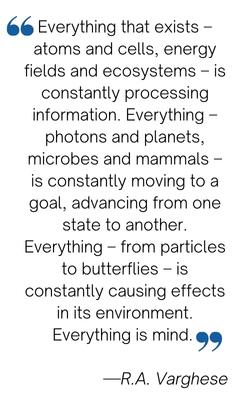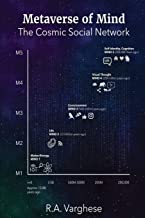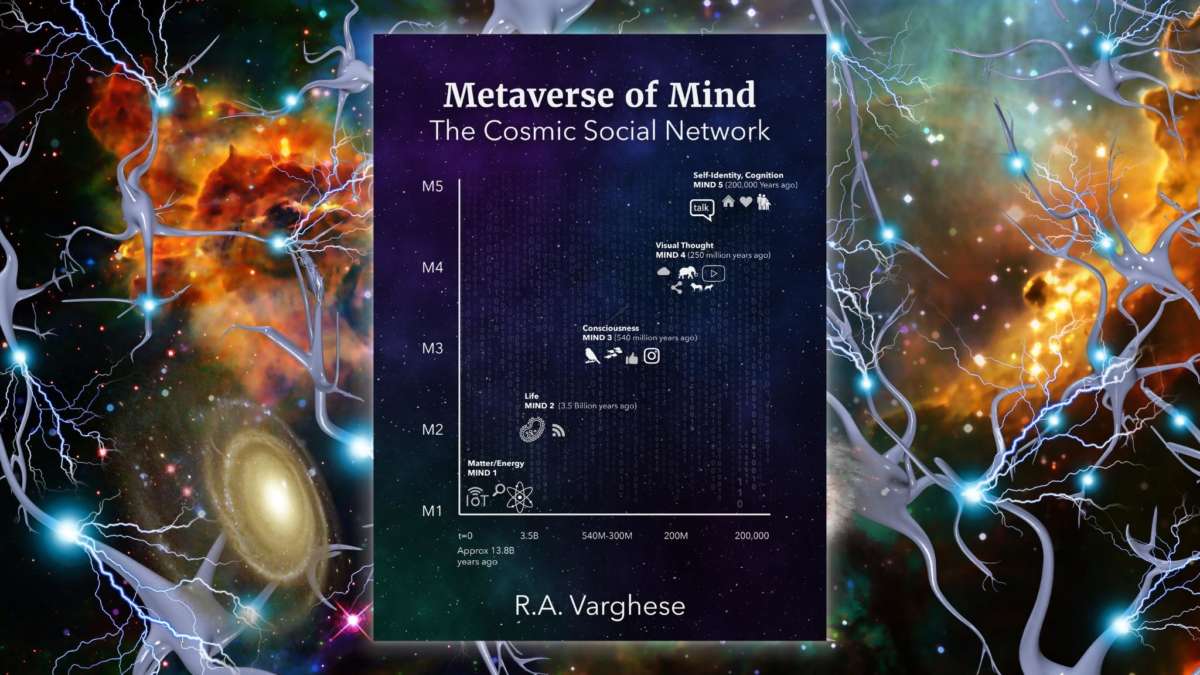Metaverse of Mind: The Cosmic Social Network by R.A. Varghese
The cosmos is a network of networks, and everything that exists in it has some form of intelligence that is part of a larger “mind.” That’s the main premise of Metaverse of Mind: The Cosmic Social Network (BlackBox) by interdisciplinary thinker R.A. Varghese. Within its pages lies a well-constructed series of arguments, clearly laid out and full of delightfully creative — and even poetic — writing.
 Varghese takes us on a journey through time, life and matter to show how denizens of the “mindfield” evolved from the dawn of the cosmos to today through what can be seen as a series of upgrades in cognition, each building on the other until we reached the variety and complexity of forms we see today — including humans. We begin with the mathematically structured world of energy and matter (Mind 1) and proceed through four more “domains of mind,” with each domain more complex in function than the one before it. These domains are further broken down into various “kingdoms” of mind types, which in turn contain “agents” that manifest these mind types.
Varghese takes us on a journey through time, life and matter to show how denizens of the “mindfield” evolved from the dawn of the cosmos to today through what can be seen as a series of upgrades in cognition, each building on the other until we reached the variety and complexity of forms we see today — including humans. We begin with the mathematically structured world of energy and matter (Mind 1) and proceed through four more “domains of mind,” with each domain more complex in function than the one before it. These domains are further broken down into various “kingdoms” of mind types, which in turn contain “agents” that manifest these mind types.
At the lowest rung, these “agents” begin as energy and the building blocks of matter, followed by microbes; plants; insects and reptiles; aquatic and aviatic species; mammals; and finally, humans. The more complex the domain of mind, the more “powers” these agents possess. But even in the lowest domain of mind (Mind 1), there is a kind of intelligence that enables its agents to process information; create effects; move toward goals; adapt to environments; and interact and share information with other agents.
This last characteristic is key to Varghese’s approach — that all energy, matter and life are part of a “cosmic social network” made up of platforms specific to the type of minds that use them. This is the “glue” that holds all of these manifestations of mind together in a “network of networks.” For these, he draws comparisons between the interactions of entities and types of digital networks, social or otherwise, that we are familiar with.
The table below is a summary of how it all comes together:
| DOMAIN | KINGDOM(S) AND AGENTS | ANALOGOUS NETWORK(S) |
| Mind 1 (Matter/Energy) | MindCloud (quantum fields and the mathematically based laws and constants of nature) | IoT (Internet of Things), Twitter |
| Mind 2 (Life, which also contains the qualities present in Mind 1) | Mind-bots (microbes)
Mind-pods (plants) |
RSS feeds |
| Mind 3 (Consciousness, which also contains the qualities of Minds 1 & 2) | Mind-lings (reptiles, insects)
Mind-lets (birds, fish) |
Facebook, Instagram |
| Mind 4 (Visually Based Thought, which, you guessed it, also contains the qualities of Minds 1-3) | Mind-forms (non-human animals) | YouTube |
| Mind 5 (Self-Identity, Concept-Based Thought), which, well you know the drill now | Minds (homo sapiens) | SMS |
Believe me, this will all make perfect sense once you’ve seen how Varghese stitches it together. You’ll never see the world the same way again. And if this isn’t enough to fill your own mind to the brim, Varghese also explores the implications of such a philo-scientific structure on the tenets of religion, including Creationism, the concepts of God and the Divine, and more.
It’s hard to say what is more remarkable — the fact that elements of Varghese’s theses are not unique to him (he provides ample supporting examples of thought from philosophers, scientists and mathematicians) … or the fact that Varghese has created a system for understanding how these ideas all relate in a larger context.
Much more information than I can go into here is available on the MetaverseOfMind website, but it is the book itself that does the best job of explaining it all clearly and fully. Armchair philosophers and general-market science readers alike will find Metaverse of Mind an accessible exploration of the nature of existence, from a vantage point that sits at the enlightening intersection of science, philosophy and religion.
WATCH THE BOOK TRAILER HERE
About R.A. Varghese:
R.A. Varghese is the author and/or editor of fifteen books on the interface of science, philosophy and religion. His Cosmos, Bios, Theos, hailed by Time magazine as “the year’s most intriguing book about God,” included contributions from 24 Nobel Prize-winning scientists. Cosmic Beginnings and Human Ends, a subsequent work, won a Templeton Book Prize for Outstanding Books in Science and Natural Theology. His The Wonder of the World was endorsed by leading thinkers including two Nobelists and was the subject of an Associated Press story. He co-authored There is a God – How the World’s Most Notorious Atheist Changed His Mind with Antony Flew (a book translated into Spanish, Portuguese, Korean, Russian, and Arabic). He is also author of There is Life After Death – Compelling Reports from Those Who Have Glimpsed the Afterlife (with a foreword from Raymond Moody, author of the best-selling Life After Life), God-Sent: A History of the Accredited Apparitions of Mary, God-Fleshed: A Chronicle of the Comings of Christ, and The Christ Connection – How the World Religions Prepared the Way for the Phenomenon of Jesus. Varghese was a panelist at the science and religion forum in the Parliament of World Religions held in Chicago in 1993 and an invitee and participant in the Millennium World Peace Summit of Religious and Spiritual Leaders held at the United Nations in August 2000. Varghese has been interviewed on numerous radio and TV shows including “Coast to Coast.” He has also been profiled in different print publications.




